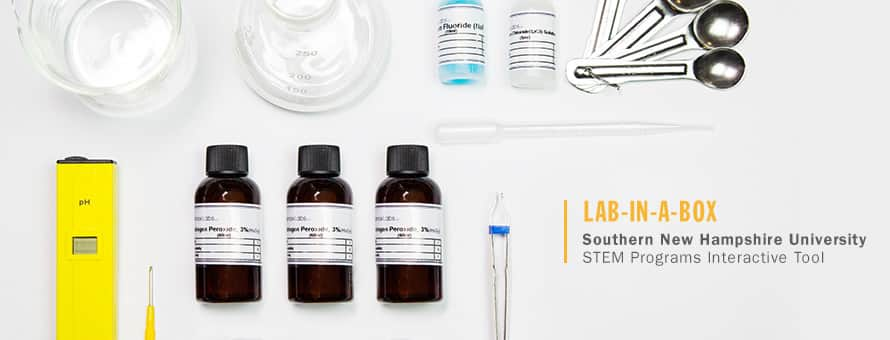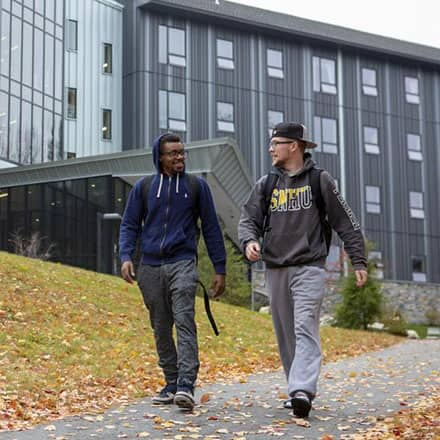Online Interactive Learning Tools

The fundamentals of online learning are "read, write, respond." But for many students, that's no longer enough: They need the experience, help and stimulation offered by online interactive learning tools.
Keeping students engaged is a key goal for course designers at SNHU Online, says Eddie Fournier, director of Academic Technology and Course Production. That's especially true for many of SNHU Online's newer academic programs, such as the STEM disciplines, healthcare and criminal justice, but also true of more established fields such as business.
"You've got to do more than just PDFs and Word files," Fournier says. "How do we make things more interesting, more interactive, and not have students feel like they're just reading?"
SNHU Online is answering that question by incorporating different media, software and practical tools, from the simple to the sophisticated. For a couple of years, students in public speaking classes have used their laptops or smart phone cameras to record and upload videos, while math and accounting students have used interactive textbooks that incorporate quizzes and drop-down tutorials.
The palette of online interactive learning tools is growing rapidly. Science students now get a complete lab-in-a-box mailed to them at home so they can perform real experiments. Nursing students use video game-like software to evaluate virtual patients. Business students run competing companies in a multiplayer game.
Crime Scene Clues
A good example of a simple and effective in-house tool is a pair of narrated crime scene slideshows, one involving domestic violence, the other a shooting, created for CJ 202 Writing for the Criminal Justice System.
Students, in the role of first responding officer, "walk" through the crime scene via a series of slides. They observe spent bullets and bloodstains. They question the victim and witnesses while an ambulance siren wails in the background. The slideshow may be confusing, like a real crime scene, but students need to make sense of it, quickly identifying what's important, making accurate observations and writing field notes that will stand up in court or aid detectives taking over a case, says Dr. Jeffrey Czarnec, associate dean.
"You can't make assumptions and you can't leave anything out," says Czarnec, who served for 22 years with the Manchester, New Hampshire, police. "You can talk about these things until you're blue in the face, but this gives students a chance to actually immerse themselves in that role."
Czarnec says many criminal justice students are kinesthetic learners, who learn best by doing. For students "weaned on bombs, guns and biceps ... we need to go beyond text-based learning. At least two of their other senses are captured - sight and sound."
Videos add a third dimension: motion. For CJ 104 Ethics and the Criminal Justice Leader, Fournier's team recorded brief videos of Hollis, New Hampshire, Police Chief James Sartell asking questions about ethical decision-making. Students must record and upload audio files with their responses. The assignments help prepare students for the real-life hiring process, when a panel of officers will toss questions at them, says instructor Bob Harrington, a retired Massachusetts State Police sergeant.
"I think it's fantastic. It brings in a little dose of reality," Harrington says. "We're showing them exactly what they're going to face."
Healthy Habits
Nursing students also need to hone their observation and communication skills. So Carol Allen, a nursing lead faculty member and former assistant dean of nursing, was thrilled when she saw a demo of Shadow Health's health assessment software at a conference, featuring virtual patient "Tina Jones."
"I'd been looking for a product like this for two or three years," Allen says.
Students navigate Jones's hospital room, drawing a privacy curtain, washing their hands, putting up her bed rails, asking about her health history, discussing her symptoms, looking at her medications and chart, reviewing test results and listening to her heart, lungs and bowels.
"The program allows students to practice in a safe setting. No one's going to get hurt, no one's going to be offended, and they can practice as much as they want until they get the competency," says Allen, who helped design the class and serves on Shadow Health's board of advisors.
Karen Toland, 57, of Northborough, Massachusetts, is a senior nursing supervisor at UMass Memorial Marlborough Hospital and an R.N. working toward her Master of Science in Nursing. She thinks the software is an excellent training tool and the online course is more comprehensive and challenging than a face-to-face class.
"This is much more intense," she says. "You can't lay in the weeds and hide at the back of the class."
Nick Carte, a nursing lead faculty member who has helped Shadow Health develop more virtual patients who represent a range of ages, races, health problems and healthcare settings, says the software has some advantages over a traditional classroom with a single, live practice patient who offers only one type of lung or heart sound.
"In the virtual environment, they have the opportunity to listen to a variety of abnormalities," he says. (For their final assignment, students perform a head-to-toe assessment of a live practice patient, usually a friend or family member.)
Less glamorous, but equally important, healthcare students now have access to a virtual desktop provided by the certifying organization for health information management professionals. Students learn how to use electronic medical records on software they're likely to encounter at work, says Dr. Janice Buck, an adjunct instructor and nurse with a Ph.D. in computer science.
"I would like to have some sort of teaching tool or a lab tool like this for almost every class I teach because it's so helpful," Buck says.
Do Try This at Home
A key aspect of science is experimentation, so chemistry sets, robots and other interactive learning tools are essential in STEM classes, says Angela Foss, associate dean of STEM programs.
As she talks, Foss makes a small robot travel in circles on a tabletop by typing commands into her laptop. The Finch robot, shaped like a manta ray on wheels, costs less than $100 and has sensors for light, temperature and obstacles; a penholder for writing; an accelerometer and buzzer; a tail it can stand on; and a glowing nose that changes colors. Students taking robotics (IT 209) learn how to control the robot by writing code in SNAP and Java. The robot also supports more than a dozen programming languages.
"Students purchase this like they would purchase a textbook and get it in the mail," Foss says. "They can go beyond what is taught in the course, if they want - and it's theirs to keep."
Students studying chemistry, physics, biology and geology get lab-in-a-box kits mailed to their homes. The kits are customized to SNHU's curriculum, and course design experts try to keep the cost under $100, so they are affordable.
Instructor Fred Bernardin piloted the chemistry lab last spring, first practicing all the experiments himself and taking pictures of important steps to post in our online learning environment.
Students test and compare the acidity of ketchup and salsa, use a homemade calorimeter to test the heat capacity of metals and make the volume of gasses expand and shrink.
Environmental science student Scott Malusi, 44, of Shepherd, Michigan, is an environmental technician with an associate degree in chemistry. He was impressed with the chemistry kit, which contains a lot of the same equipment he uses at work. Real experiments, possible through online interactive learning tools, give students invaluable experience - even when they don't go as planned, says Malusi, who is now taking the biology class and lab.
Recently Malusi was supposed to compare the rate of yeast growth on five different sweeteners by trapping and measuring the gas given off, but two of his yeast colonies grew so fast they overflowed their test tubes - and the gas escaped.
With a lot of labs, they don't always go exactly as it's written out," he says. "That's part of what teaches you critical thinking - you have to figure out what went wrong."
When students have problems with a lab, Bernardin says he supplies them with sample data so they still have something to analyze and can complete the module.
"We recognize that not everything's going to go perfectly for you. The important thing is to get the connections and the understanding," says Bernardin, who is helping develop the new physics lab-in-a-box.
IT, data analytics and math students also use virtual desktops that provide programming or computational software. They save a bundle of money because they don't have to buy multiple, expensive applications. It also saves tech support from having to troubleshoot software installation for thousands of students using a wide range of computers.
"It provides a consistent experience from student to student and allows the faculty to support what students are doing," Foss says.
Beyond Monopoly
Remember how much fun it was playing Monopoly as a kid? Undergraduate business students play a grown-up version of the game in their final term: Capstone, a multiplayer simulation in which each student takes over one of eight business units resulting from a monopoly breakup.
Students have to decide on their business strategy going forward. Which products or services will they offer? (Think of the AT&T breakup, when some business units manufactured telephone handsets and others offered long-distance calling plans.) How will they finance their new company: by selling stock or wooing private investors? As the term proceeds, with each week representing a year in the company's life, students compete to capture a profitable share of the market, using all the skills they've learned as business majors, in a safe environment through online interactive learning tools.
"It's fun and it brings out a competitive spirit," says Kim Blanchette, associate dean of Undergraduate Business. "This is their opportunity to demonstrate everything they've learned in the entire program."
SNHU sets up the simulation so each student must wear every management hat: operations, finance, research and development, marketing and sales, and human resources, says Dr. Joe Cappa, executive director of Undergraduate Business.
"They are forced out of their comfort zone, or they get to try different things," he says.
The simulation has been a huge hit with students, who are not graded on whether their businesses succeed or fail, but on the quality of the reasoning behind the decisions they make, Cappa says.
Other simulations used in business classes include a virtual stock-trading program, where students make investment decisions based on real-time market data using fantasy money.
Engaging students interactively helps them retain what they're learning by applying it. It's also vital to SNHU's mission of giving them practical tools for their careers, Czarnec says.
"We need visual appeal. We need to go beyond text-based learning," he says. "We need to capture their attention for a little bit longer."
Explore more content like this article

How an Online Learning Community Can Transform Your Education

How to Deal With Stress in College

What is Gen Z Looking for in College?
About Southern New Hampshire University

SNHU is a nonprofit, accredited university with a mission to make high-quality education more accessible and affordable for everyone.
Founded in 1932, and online since 1995, we’ve helped countless students reach their goals with flexible, career-focused programs. Our 300-acre campus in Manchester, NH is home to over 3,000 students, and we serve over 135,000 students online. Visit our about SNHU page to learn more about our mission, accreditations, leadership team, national recognitions and awards.

